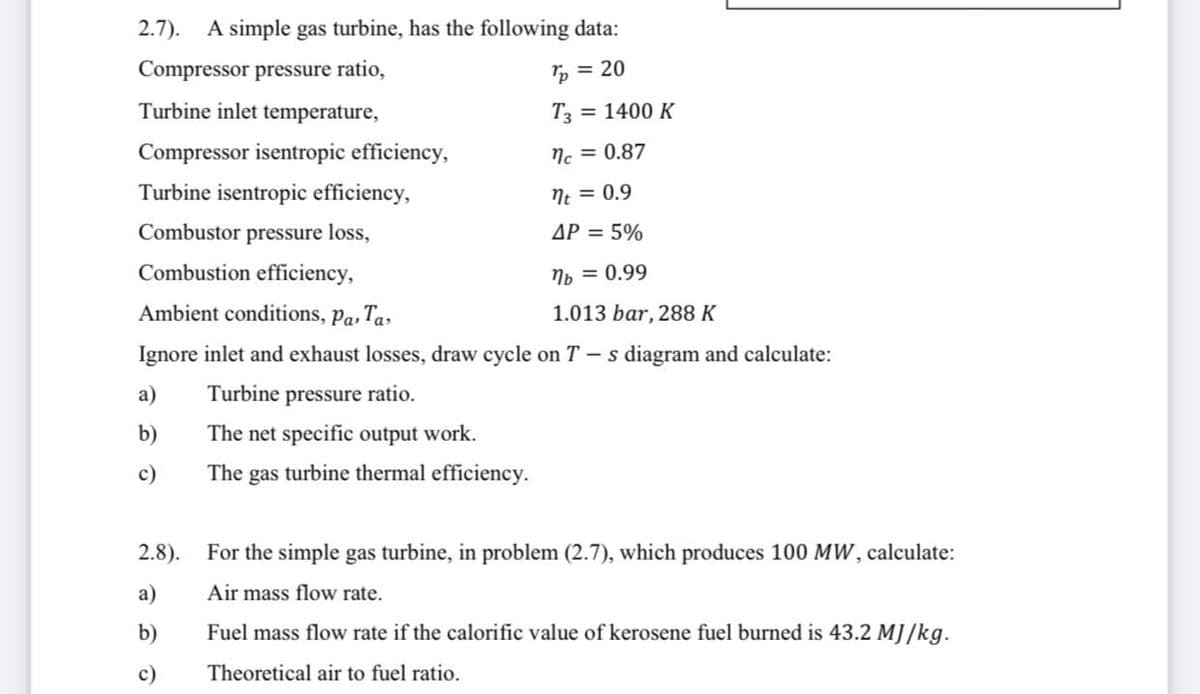2.7). A simple gas turbine, has the following data: Compressor pressure ratio, p = 20 Turbine inlet temperature, T3 = 1400 K Compressor isentropic efficiency, Nc = 0.87 Turbine isentropic efficiency, ne = 0.9 Combustor pressure loss, AP = 5% Combustion efficiency, Np = 0.99 Ambient conditions, pa, Ta, 1.013 bar, 288 K Ignore inlet and exhaust losses, draw cycle on T- s diagram and calculate: а) Turbine pressure ratio. b) The net specific output work. c) The gas turbine thermal efficiency.
2.7). A simple gas turbine, has the following data: Compressor pressure ratio, p = 20 Turbine inlet temperature, T3 = 1400 K Compressor isentropic efficiency, Nc = 0.87 Turbine isentropic efficiency, ne = 0.9 Combustor pressure loss, AP = 5% Combustion efficiency, Np = 0.99 Ambient conditions, pa, Ta, 1.013 bar, 288 K Ignore inlet and exhaust losses, draw cycle on T- s diagram and calculate: а) Turbine pressure ratio. b) The net specific output work. c) The gas turbine thermal efficiency.
Elements Of Electromagnetics
7th Edition
ISBN:9780190698614
Author:Sadiku, Matthew N. O.
Publisher:Sadiku, Matthew N. O.
ChapterMA: Math Assessment
Section: Chapter Questions
Problem 1.1MA
Related questions
Question

Transcribed Image Text:2.7). A simple gas turbine, has the following data:
Compressor pressure ratio,
Tp = 20
Turbine inlet temperature,
T3
= 1400 K
Compressor isentropic efficiency,
Nc = 0.87
Turbine isentropic efficiency,
Ne = 0.9
Combustor pressure loss,
AP = 5%
Combustion efficiency,
Np = 0.99
Ambient conditions, Pa, Ta»
1.013 bar, 288 K
Ignore inlet and exhaust losses, draw cycle on T – s diagram and calculate:
a)
Turbine pressure ratio.
b)
The net specific output work.
c)
The gas turbine thermal efficiency.
2.8).
For the simple gas turbine, in problem (2.7), which produces 100 MW, calculate:
a)
Air mass flow rate.
b)
Fuel mass flow rate if the calorific value of kerosene fuel burned is 43.2 MJ/kg.
c)
Theoretical air to fuel ratio.
Expert Solution
This question has been solved!
Explore an expertly crafted, step-by-step solution for a thorough understanding of key concepts.
This is a popular solution!
Trending now
This is a popular solution!
Step by step
Solved in 3 steps with 3 images

Knowledge Booster
Learn more about
Need a deep-dive on the concept behind this application? Look no further. Learn more about this topic, mechanical-engineering and related others by exploring similar questions and additional content below.Recommended textbooks for you

Elements Of Electromagnetics
Mechanical Engineering
ISBN:
9780190698614
Author:
Sadiku, Matthew N. O.
Publisher:
Oxford University Press

Mechanics of Materials (10th Edition)
Mechanical Engineering
ISBN:
9780134319650
Author:
Russell C. Hibbeler
Publisher:
PEARSON

Thermodynamics: An Engineering Approach
Mechanical Engineering
ISBN:
9781259822674
Author:
Yunus A. Cengel Dr., Michael A. Boles
Publisher:
McGraw-Hill Education

Elements Of Electromagnetics
Mechanical Engineering
ISBN:
9780190698614
Author:
Sadiku, Matthew N. O.
Publisher:
Oxford University Press

Mechanics of Materials (10th Edition)
Mechanical Engineering
ISBN:
9780134319650
Author:
Russell C. Hibbeler
Publisher:
PEARSON

Thermodynamics: An Engineering Approach
Mechanical Engineering
ISBN:
9781259822674
Author:
Yunus A. Cengel Dr., Michael A. Boles
Publisher:
McGraw-Hill Education

Control Systems Engineering
Mechanical Engineering
ISBN:
9781118170519
Author:
Norman S. Nise
Publisher:
WILEY

Mechanics of Materials (MindTap Course List)
Mechanical Engineering
ISBN:
9781337093347
Author:
Barry J. Goodno, James M. Gere
Publisher:
Cengage Learning

Engineering Mechanics: Statics
Mechanical Engineering
ISBN:
9781118807330
Author:
James L. Meriam, L. G. Kraige, J. N. Bolton
Publisher:
WILEY